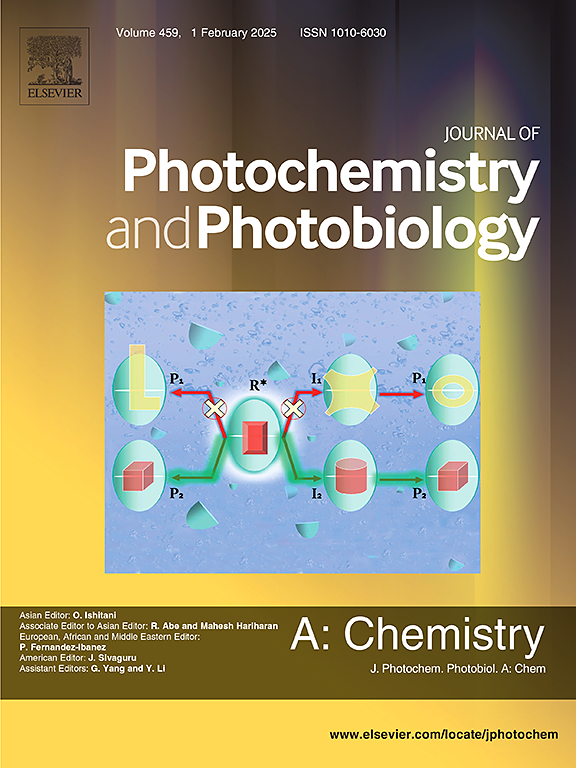Studies on Radiosensitization with mycosporine-like amino acids and aromatic amino acids
IF 4.1
3区 化学
Q2 CHEMISTRY, PHYSICAL
Journal of Photochemistry and Photobiology A-chemistry
Pub Date : 2025-04-23
DOI:10.1016/j.jphotochem.2025.116457
引用次数: 0
Abstract
Mycosporine-like amino acids (MAAs) is a generic name for compounds with cyclohexenone or cycloheximine rings. MAAs absorb UV radiation and dissipate it as heat; thus, they exhibit antioxidant activity. Radiodynamic therapy (RDT) is a treatment modality that combines radiotherapy with a sensitizer to augment therapeutic effects. RDT is based on chemicals that produce reactive oxygen species (ROS) under X-ray irradiation. Recently, several radiosensitizers are being developed and characterized as producers of ROS under UV irradiation. Therefore, in this study, we focused on MAAs as radiosensitizers, and evaluated ROS production from MAAs and aromatic amino acids under X-ray and UV irradiation. Aromatic amino acids were selected because they have structures similar to those of MAAs. MAAs showed radical scavenging abilities but did not produce ROS under X-ray and UV irradiation. The fact that MAAs did not function as ROS producers under X-ray irradiation indicates that they are not suitable for RDT applications; however, because they did not produce ROS under UV irradiation, they might be important for application in the production of cosmetics. Surprisingly, histidine produced hydroxyl radicals and superoxide anions under UV and X-ray irradiations. Thus, the present study provides a paradigm for identifying compounds that can effectively enhance RDT.

类真菌菌素氨基酸和芳香氨基酸的放射致敏研究
类真菌菌素氨基酸(Mycosporine-like amino acids, MAAs)是具有环己酮或环己胺环的化合物的通称。MAAs吸收紫外线辐射并将其作为热量消散;因此,它们表现出抗氧化活性。放射动力学治疗(RDT)是一种结合放射治疗和增敏剂以增强治疗效果的治疗方式。RDT是基于x射线照射下产生活性氧(ROS)的化学物质。最近,一些放射增敏剂被开发出来,并被认为是紫外线照射下活性氧的生产者。因此,在本研究中,我们重点研究了MAAs作为放射增敏剂,并评估了MAAs和芳香氨基酸在x射线和紫外线照射下产生的ROS。选择芳香氨基酸是因为它们具有与MAAs相似的结构。在x射线和紫外线照射下,MAAs具有清除自由基的能力,但不产生活性氧。MAAs在x射线照射下不能产生ROS,这表明它们不适合RDT应用;然而,由于它们在紫外线照射下不产生活性氧,因此在化妆品生产中可能具有重要的应用价值。令人惊讶的是,组氨酸在紫外线和x射线照射下产生羟基自由基和超氧阴离子。因此,本研究为识别能够有效增强RDT的化合物提供了一个范例。
本文章由计算机程序翻译,如有差异,请以英文原文为准。
求助全文
约1分钟内获得全文
求助全文
来源期刊
CiteScore
7.90
自引率
7.00%
发文量
580
审稿时长
48 days
期刊介绍:
JPPA publishes the results of fundamental studies on all aspects of chemical phenomena induced by interactions between light and molecules/matter of all kinds.
All systems capable of being described at the molecular or integrated multimolecular level are appropriate for the journal. This includes all molecular chemical species as well as biomolecular, supramolecular, polymer and other macromolecular systems, as well as solid state photochemistry. In addition, the journal publishes studies of semiconductor and other photoactive organic and inorganic materials, photocatalysis (organic, inorganic, supramolecular and superconductor).
The scope includes condensed and gas phase photochemistry, as well as synchrotron radiation chemistry. A broad range of processes and techniques in photochemistry are covered such as light induced energy, electron and proton transfer; nonlinear photochemical behavior; mechanistic investigation of photochemical reactions and identification of the products of photochemical reactions; quantum yield determinations and measurements of rate constants for primary and secondary photochemical processes; steady-state and time-resolved emission, ultrafast spectroscopic methods, single molecule spectroscopy, time resolved X-ray diffraction, luminescence microscopy, and scattering spectroscopy applied to photochemistry. Papers in emerging and applied areas such as luminescent sensors, electroluminescence, solar energy conversion, atmospheric photochemistry, environmental remediation, and related photocatalytic chemistry are also welcome.

 求助内容:
求助内容: 应助结果提醒方式:
应助结果提醒方式:


